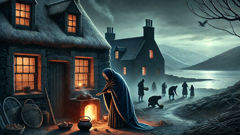Introduction
On the ridge where the wind first learns its name, where granite bones rise like the ribs of the world and peat folds down into secret rivers, the old stories say the Cailleach Bheur wakes. Not born in silence but brought forth by the world’s need for winter—by the hush that allows seeds to rest and streams to gather memory—she arrives with a shawl full of knives and a staff made from the spine of a stag. Her hair is the grey of late frost and her eyes hold the pale, clear light of snowfields. To the people of the crofts and the scattered hamlets she is a presence older than kings, a maker whose moods shape the map: valleys folded under snowdrifts where she has slept, crags that were massed and hammered under her hands, loch-edges carved by the scrape of her nails. This is not a tale of only terror. In old speech she is also an artisan and a gardener of endings. When she walks a glen it becomes honest—trees stripped to truth, ground reduced to its bones, pathways cleared of the chatter of summer’s abundance so that what lives beneath may be reckoned with. The Cailleach is the personification of winter, but she is also a creator deity, a divine hag who knits frost into the pattern of the land. People understood that bargained ways kept the world turning: small offerings of bread at the first snowfall, a field left unswept for her to rest on, songs hummed beneath the eaves when her cold fingers rubbed at the panes. Such customs survived for centuries because survival is a form of storytelling; each winter was a chapter in the long contract between human hands and the hag’s relentless craft. To speak of her is to speak of transformation—how flowing water becomes glass, how green becomes silver, how an old woman’s eyes can hold the memory of mountains that do not fit on any map. Across glens and islands, names and stories shift—sometimes she is Cailleach Bheur, the pale hag; sometimes she becomes a figure called Bheur or Cailleach of the snows—but the core remains: winter must come, and someone must tend it. In the hush before the first major frost, elders would gather children close and trace the white curve of her staff on a flat stone, telling about the nights she walked with a sack of stone to build hills and wipe the world clean of rot and excess. The myth that follows is a weaving of voices—song, complaint, warning, gratitude—an attempt to put in words the ways a people lived alongside a goddess whose rule was not merely weather but a shaping of fate itself.
Origins, Names, and the Work of Stone
In the oldest tongues, the word cailleach meant a veiled woman, a crone. Yet the veiling was not always a sign of decline; it was a sign of authority. The Cailleach Bheur wears many names across Scotland—Cailleach na Beinne, the Hag of the Mountain; Cailleach an Ois, the Hag of the Winter Entrails. Each name carries a regional inflection, the memory of a glen or an island, but each traces to the same figure: a maker whose year is the circuit between the cold’s opening and its closing. Her origin stories vary like weather on the west coast. In one telling she is older than the hills—present at the forming of lochs, the settling of stones, the shaping of horseshoe curves in rivers. In another, she is once mortal, a wise woman who refused to die and took on the winter’s mantle to protect vulnerable flocks. No matter the version, her gift is an artisanal violence. She does not merely drop snow; she sculpts. Saplings become columns of ice, ridges are hewn into new faces, and where she stamps her staff the land rises into a cairn or a hill. People who lived nearest to those features would mark the places with small altars—an old boot, a chipped pot—to acknowledge the work done and to ask for mercy when the storming began.

The Cailleach’s hands are described in paradox: clumsy because they are huge enough to move boulders, precise because she threads frost like fine lace across a window. When she sings—long toneless vowels heard like wind through reed—the sea hushes and the gulls circle lower, as if listening. In a story from the western isles, she carried a bag of names; every winter night she took one name and set it inside a stone, sealing memory into rock so villagers would not forget who they were and why they had to be careful with the land. That is one of her lesser-known acts: the creation of landmarks that hold story. The standing stone at the head of a valley is not merely a happenstance of geology but a ledger of names and deeds, a ledger the old women could read if they still knew the old songs.
The Cailleach’s rule is cyclical and negotiated. She measures winter with a handful of snow, tasting each flake for its honesty. The length of her reign can be extended or shortened by human deeds. Traditionally, communities tracked her temperament—an early hard frost meant she had awoken in anger; a late, soft snowfall indicated fatigue. In many parishes it was said that if the Cailleach could find a comfortable place to sleep before Beltane, she would hibernate until the following autumn and grant a milder season. Conversely, a restless Cailleach prowling the hills foretold a long season of cold, and families would hedge their bets: extra stores of peat, more knitting of warm garments, fasting on key nights to placate her. These rites were not superstition alone; they were pragmatic responses to a climate that could kill as easily as it could teach resilience. The ritual economy—bread left on window sills, milk poured into hollows, a single tuft of yarn unpicked and offered—shows how myth and subsistence braided together.
Beyond rituals, the Cailleach’s presence shaped art and language. Songlines, poems, and place names encoded weather wisdom across generations. To call a summit ‘Cnoc na Cailleach’ publicly acknowledged that the hill might have been touched by her hands. This was language as landscape management, a way to teach children which bogs to avoid and which ridges to trust for shelter. The stories also carried moral tones. The Cailleach rewarded craft and caution and punished greed: families that hoarded grain or cut too heavily into the common woodlands found their wells frozen and their ewes barren. Yet she was not cruel for cruelty’s sake. Her judgments were curricula in ecological thinking—small societies learned to steward resources because a goddess of seasons could make or unmake harvests. In that way she functioned as a deity of collective memory and accountability.
There are tales that put the Cailleach against other figures of light. One common motif is her uneasy rivalry with the goddess of summer—figures sometimes named Brìghde or Beira—whose warmth and fertility balance the Cailleach’s necessary harshness. These duelings were not simple moral binaries of good versus evil; rather they dramatized the alternation of states: rest and regeneration against purging and sharpening. In some accounts the two women are two faces of the same being, shifting with the changing seasons—one the midwife of rebirth, the other the midwife of conclusion. In others they bargain and contend: the Cailleach may pile snow into a mound to hide the summer’s flowers, while her counterpart returns fire to the fields. Those narratives were ways communities processed seasonal risk—if the Cailleach won too many contests, one prepared for scarcity; if Brìghde found more victories, one planned a fuller harvest.
The Cailleach’s relationship with death is tender rather than spiteful. She presides over endings because endings clear the way for beginning. Her winter grasps at the land so that the rot and overgrowth of summer are consumed and reorganized. That consumption is an act of renewal, if renewal requires an interval of absence. Elder people remembered losses of kin in the wink of a frost, and the offers they laid at her small, secret altars were less bribes than remembrances—gifts so the Cailleach might carry a name into the long dark and keep it unblinded by time. To know that a beloved’s memory was sealed in a cairn or whispered into peat was to accept loss and to trust in the return of green. The paradox of a goddess who makes both stone and song is one reason her figures became anchors for both landscape and identity: she was an explanation for why the hills look the way they do, and a guide for how to live with the seasons’ necessities.
Winter’s Craft, Human Encounters, and Lasting Rites
The work of winter, as the Cailleach performs it, is not only geological. It is social and moral. Farmers and crofters learned to read the sky as a ledger of her moods: the way snow lowered itself like linen over the lichen indicated she had found the loch-bed’s breath; a blackening sleet warned that her temper had hardened. There are recorded tales of people encountering the Cailleach directly—an old shepherd finding a white-shawled woman stirring the embers of a peat fire on a lonely moor, a child given a crooked coin after leaving a bowl for her under the eaves. Sometimes she appears generous, handing a protective charm for the winter’s cold; sometimes she is demanding, insisting that the hearth be kept and the only spare tableware left out until her sleep is certain. These stories function like counsel: offering respect to a force makes survival likelier, but the exchange must be honest. She despises deceit. Those who attempted to trick winter—by hoarding peat or by pretending a barn’s straw was full of grain when it was not—found their wells iced over and their doors riven with frost.

There are striking encounters that reveal the Cailleach’s ambivalence. A persistent favorite tells of a widow who kept a small fire burning night after night in her stone cottage. When the Cailleach came to take away the warmth, moved by the widow’s steadfastness, she left behind a single stone that would not freeze—a talisman that allowed the widow to keep a piece of summer’s heat through the bleak midwinter. Another tale speaks of a boatman who refused to ferry the hag across a swollen winter inlet. In anger she stilled the sea and made a pool of ice, stranding the boatman’s family and forcing him to humbly walk the new road she had sculpted to restore passage. Those stories keep the relation between the divine and the human lively: there is room for argument, compromise, and even gratitude.
Ritual practice around the Cailleach adapted as communities shifted. In coastal villages, fishermen would throw a net ashore on the first heavy snow as an offering; inland, shepherds left a bone or a cup of milk in the hollow of a wall. The midwinter hearth had its own etiquette—steady embers, a plain meal, a quiet song—to which the Cailleach responded. In some districts, the arrival of winter was marked with a single ‘making’ ceremony: an elder woman, often described as the local cailleach in human form, would be dressed in a coarse blue shawl and led to the headland, where villagers would sing her into the year’s dark. If that woman was treated with respect, the season was said to be more merciful; if mistreated, the long freeze would harden into calamity. This ritualized personification is evidence of the myth’s elasticity: communities put a face on the abstract so that they could negotiate with it.
Beyond local rites, the Cailleach’s presence filtered into material culture. Carved stones often bear rough marks thought to be her signatures—scratches in a certain diagonal pattern, a repeated notch thought to mark where she leaned her staff. These marks are regional scripts, and scholars who study them argue that they helped preserve local identity. Weaving patterns sometimes mimic frost’s fractal geometry, and lullabies incorporate the cadence of wind against window slats. There is even a subtle architecture of survival embedded in cottages: small attics and smoke-holes, thick walls of turf and stone, beds raised from cold floors—a vernacular informed by centuries of winter governance.
As the modern age brought coal and calendar making, some practices around the Cailleach faded. Yet the stories persisted, recited in kitchens where gas flames now replace peat, whispered on stormy nights, and recorded in parish books. Even when the direct fear of starvation receded, the Cailleach remained an interpreter of decline and restraint: she is summoned when economies contract, when people move away from land and the community’s mutual obligations become thin. Her myth is adaptable; it migrates from weather to consequence, from frost to a metaphoric winter of the spirit. Contemporary storytellers have reanimated her in new ways—some portray her as a defender of wild places against modern exploitation, others as a cautionary emblem against complacency. Poets now find in her a language for ageing and for the seasons of care and loss that structure human life.
There is a quieter aspect to her rule that modern ears sometimes miss. The Cailleach is ultimately about rest. Under her reign, seeds lie in dark cold until they are ready to push. Rivers slow and reflect star-lights, and animals go inward. In the small, enforced economy of winter, cultures learned the arts of mending, remembering, and conserving. The ancient practice of 'keeping the winter'—the idea of making domestic life a priority while the world outside rests—was a cultural technology for resilience. In those months people repaired tools, taught children songs, and told the stories that would be seeds in the next green year. The Cailleach, with her stern stewardship, carved time into intervals that allowed both land and people to heal.
To walk in the highlands in a hard winter is to tread where the Cailleach has been busy. Stones rearranged, heather flattened into new patterns, small hollows holding the bones of the old season—these are her signatures. And if you stand very still on a ridgeline and look into the distance when the light is thin, you may feel the sense of being watched not by malice but by a necessary force. The myth does not seek our worship as much as our attentiveness. It asks us to notice the ways we live with endings and to accept the economies of care that cold demands. In this way the Cailleach Bheur remains alive in the culture of Scotland: not only as a fearsome winter hag but as a teacher, a maker, and an unflinching reminder that some gifts come wrapped in hardship.
Conclusion
When you speak the Cailleach’s name aloud, you are not merely invoking a single old woman with a cruel laugh. You are invoking a long contract between land and people, a ritual economy shaped by weather, necessity, and the careful transactions of survival. Her myth anchors place names and cultural practices, and it disciplines the imagination to see winter not as mere absence but as a craft: an interval of sharpening, preserving, and reconfiguration. In the modern world, where seasons sometimes blur under the influence of new climates and shifting economies, the figure of the Cailleach Bheur endures as a parable and a warning: treat the land and its limits with care, respect the cycles that hold ecosystems together, and remember that endings are often the scaffolding for new beginnings. To tell her story is to remember that resilience is as much about ritual and memory as it is about tools and stores, and that the pale, patient artistry of winter has shaped both the highlands’ contours and the human hearts that live within them.













